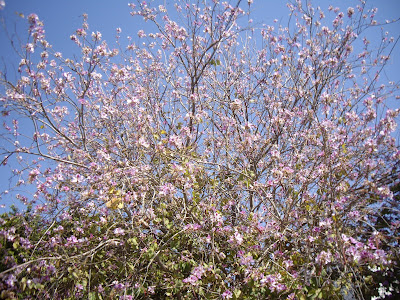από το http://www.floridata.com/ref/B/bauh_var.cfm
Description
Purple orchid tree is closely related to peacock flower (Caesalpinia pulcherrima) and to the tree many consider the world's most beautiful, the royal poinciana (Delonix regia) - and it shows! Purple orchid tree (usually just called orchid tree) is staggeringly beautiful when in bloom - and it blooms for several months! Orchid tree grows 20-40 ft (6-12 m) tall and 10-20 ft (3-6 m) wide with a spreading crown of briefly deciduous leaves which are 4-6 in (10-15 cm) across and rounded with lobed ends and heart shaped bases. The leaves are shaped a little like a cow's hoof. Some cultivars have leaves with white variegations. The flowers are reminiscent of showy orchids, with five irregular, usually slightly overlapping petals in shades of magenta, lavender or purplish blue. The flowers often make their first appearance in late winter while the tree is bare of leaves. The blooming period then lasts until early summer. The flowers are 3-5 in (7.6-12.7 cm) across and carried in clusters at the branch tips. A member of the bean family, orchid tree produces flattened brown woody legumes (pods) up to 12 in (30.5 cm) long. The cultivar 'Candida' (white orchid tree) has snow white flowers with greenish veins.
Hong Kong orchid tree (Bauhinia X blakeana is a sterile hybrid between (probably) B. variegata and B. purpurea, and is usually considered to be the most beautiful of all the orchid trees. It is a somewhat larger tree, evergreen with large thick leaves and striking purplish red flowers.
Location
Orchid trees is native to northern India, Viet Nam and southeastern China.
Culture
Orchid trees do best in acidic soil and suffer under limey conditions. They are not tolerant of salty conditions, either.
Light: Full sun. Orchid tree can tolerate very light shade from tall pines, for example.
Moisture: Water freely during the summer and less so in winter. Orchid tree may drop its leaves during winter drought, but this is not a bad thing.
Hardiness: USDA Zones 9 - 11. Orchid tree is a subtropical plant that usually recovers from brief freezes (after dropping its leaves). It gets tree sized in the tropics, but will stay shrublike where it is subjected to frost and freezing. Purple orchid tree can survive temperatures to 22°F (-5.5°C). The hybrid, Hong Kong orchid tree, is not so hardy and usually killed by temperatures below 26°F (-3.3°C).
Propagation: Seeds germinate readily. Orchid tree also can be propagated from cuttings of semiripe wood taken in summer and rooted over bottom heat. Branches can be induced to grow roots if they are layered, either by burying a section in the ground, or scarring a small section and then wrapping it with damp sphagnum moss and enclosing in a plastic bag. The tree sometimes produces suckers which can be dug up and replanted.
| |
| Compact size and long flowering season make the orchid tree suitable for small yards in Zones 9+ but select sterile hybrids in areas where this tree is invasive (like Florida). |
Orchid tree is used as a street tree, shade tree, specimen or focal tree in tropical and subtropical landscapes. It bears beautiful fragrant flowers abundantly in late winter and early spring and intermittently through summer. Orchid trees have brittle branches that can break in strong winds and they can be messy, dropping hundreds of dried pods in autumn. The hybrid, Hong Kong orchid tree doesn't produce pods because it is sterile.
Features
There are more than 200 species in the genus Bauhinia. Purple orchid tree, sometimes sold under the name B. purpurea, is the most frequently planted species. An abstract version of a Hong Kong orchid tree (B. X blakeana) blossom appears on the flag of the city-state of Hong Kong (I dunno though, it looks more like a plumeria blossom to me - Jack).
WARNING
The Florida Exotic Pest Plant Council lists the orchid tree as a Category 1 invasive species. This category identifies "invasive exotics that are altering native plant communities by displacing native species, changing community structures or ecological functions, or hybridizing with natives". This was one of the original eleven species that the Florida Nurserymen and Growers Association recommended for removal from the market by its members.


















Δεν υπάρχουν σχόλια:
Δημοσίευση σχολίου